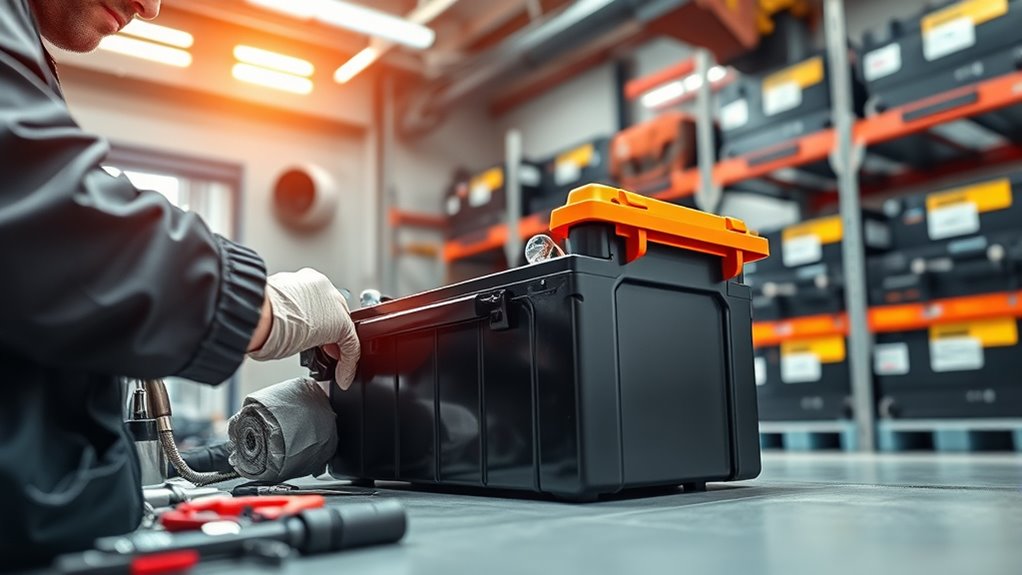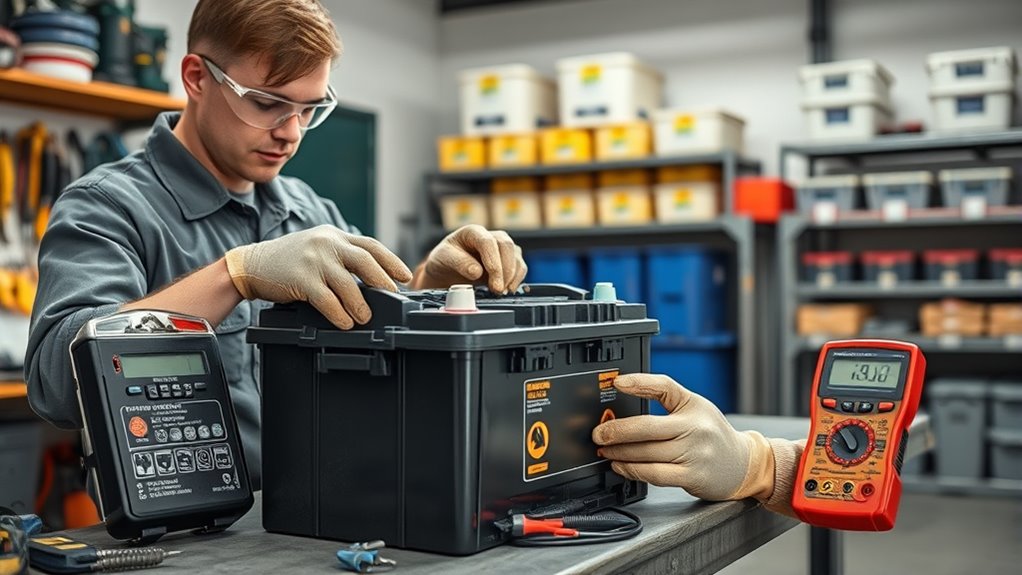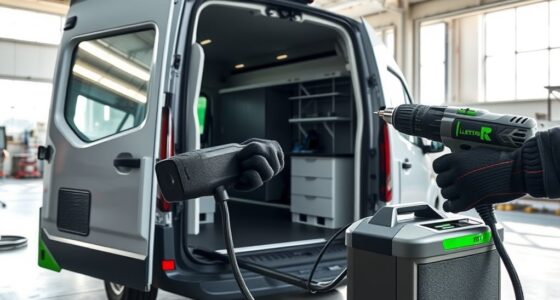Before a trip, inspect your battery for corrosion, leaks, or cracks and make certain terminals are tight. Check its voltage—around 12.6 volts indicates a good charge—and top off with distilled water if needed. During storage, disconnect the battery, keep it in a cool, dry place, and periodically check its voltage. Proper maintenance and storage extend battery life, so keep these tips in mind to keep your vehicle reliable—more helpful advice awaits if you continue.
Key Takeaways
- Conduct visual inspections for corrosion, leaks, damage, and debris around the battery terminals and case.
- Check the battery voltage with a multimeter; recharge if below 12.4 volts.
- Clean corrosion with baking soda solution, and protect terminals with petroleum jelly or spray.
- Disconnect the battery during extended storage and store in a cool, dry environment away from sunlight.
- Keep the electrolyte topped with distilled water only when fully charged and periodically verify voltage.

Before hitting the road, make sure to perform thorough battery pre-trip checks and follow proper storage practices to guarantee reliable performance. Your vehicle’s battery is a critical component that, if neglected, can leave you stranded or cause costly repairs.
Starting with a visual inspection, look for any signs of corrosion, leaks, or swelling. Corrosion appears as a white, powdery substance around the terminals and can hinder proper electrical connection. If you notice any, clean the terminals with a mixture of baking soda and water, using a wire brush to remove buildup. Ensure the terminals are tightly secured; loose connections can cause starting issues or intermittent power loss.
Inspect for corrosion, leaks, or swelling; clean terminals with baking soda, and tighten connections for reliable starts.
Next, check the battery’s charge level. Many batteries come with a built-in hydrometer, or you can use a multimeter set to the 12-volt DC setting. A healthy, fully charged battery should read around 12.6 volts or higher. If you get readings below 12.4 volts, it’s a sign that the battery needs charging or replacement.
Don’t forget to inspect the battery’s case for cracks or damage, which could lead to leaks or failure. Also, examine the surrounding area for debris or dirt that could interfere with proper ventilation and heat dissipation.
When it comes to storage, how you treat your battery over time considerably impacts its lifespan. If you’re storing your vehicle for an extended period, disconnect the battery to prevent parasitic drain, which can deplete the charge. Store it in a cool, dry place away from direct sunlight and sources of heat or moisture.
Extreme temperatures accelerate battery aging, so a consistent environment is key. If possible, remove the battery from the vehicle altogether and place it on a wooden or plastic surface—never directly on concrete, as it can draw moisture and cause damage.
While in storage, periodically check the battery’s voltage with a multimeter. If it drops below 12 volts, recharge it to maintain ideal health. Use a quality battery charger suited for your battery type, and avoid overcharging, which can damage the plates.
If your battery has a removable cap, top off the electrolyte levels with distilled water as needed, but only when the battery is fully charged. Keep the terminals clean and protected with a bit of petroleum jelly or terminal protectant spray to prevent corrosion during storage.
It is also important to be aware of the increasing bias in AI outputs, which can influence how information is presented or interpreted, especially in automated diagnostics and support systems.]
Frequently Asked Questions
How Often Should I Replace My Vehicle’s Battery?
You should replace your vehicle’s battery every 3 to 5 years, depending on its condition and usage. Regularly check for signs like slow engine cranks, dim lights, or corrosion.
If your battery is over five years old or shows these issues, it’s wise to replace it to avoid unexpected breakdowns. Proper maintenance and inspections can extend its lifespan, but don’t delay replacing it when needed for reliable vehicle performance.
Can Extreme Temperatures Damage My Battery During Storage?
Yes, extreme temperatures can damage your battery during storage. Cold weather can cause the electrolyte to thicken, reducing its ability to hold a charge.
Meanwhile, heat accelerates chemical reactions, leading to faster deterioration of battery components.
To safeguard your battery, store it in a cool, dry place, avoid direct sunlight, and check its charge periodically.
Proper storage helps extend your battery’s lifespan and ensures reliable performance when you need it.
What Signs Indicate My Battery Is Failing?
Did you know that about 50% of vehicle breakdowns are caused by battery issues?
If your battery is failing, you’ll notice slow engine starts, dimming headlights, or electrical problems.
You might also see corrosion on the terminals or a swollen battery case.
These signs indicate your battery’s losing strength, so it’s time to get it tested or replaced to keep your vehicle running smoothly.
Is It Safe to Jump-Start a Dead Battery?
Yes, it’s generally safe to jump-start a dead battery if you follow proper procedures. Connect the jumper cables correctly—positive to positive, negative to a grounded metal on the vehicle with the dead battery. Avoid sparks and make certain both vehicles are off before connecting.
Once connected, start the assisting vehicle first, then your vehicle. After running for a few minutes, disconnect in reverse order. If unsure, consult a professional.
How Do I Dispose of an Old or Damaged Battery Properly?
You should dispose of an old or damaged battery at a certified recycling center or an authorized hazardous waste facility. Never throw it in the trash or pour it down the drain, as it can leak harmful chemicals.
Before disposal, make certain the battery terminals are covered to prevent sparks.
Check local regulations for proper disposal procedures, and always handle the battery carefully to avoid leaks or injury.
Conclusion
By following these pre-trip checks and storage tips, you’ll keep your battery in top shape, ready to perform whenever you need it. Think of your battery like a trusted friend—you want to care for it so it can always be there when you count on it. Regular maintenance and proper storage are simple habits that make your journeys smoother and safer. Stay proactive, and your battery will serve you well, just like a reliable companion on every trip.









